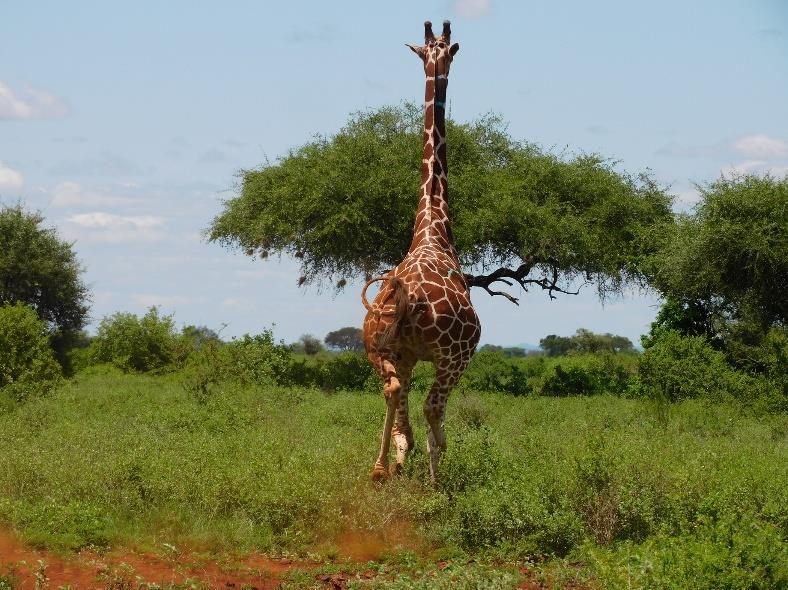
SWT/KWS MERU MOBILE VETERINARY UNIT


APRIL 2024

2 Cases in April
April Report
by Dr. Aminga Duncan

0 Poaching Cases

1 Giraffe Case
The Meru ecosystem experienced transformative rejuvenation as it was drenched in significant showers in April. Seasonal rivers coursing through Meru National Park surged to life breathing vitality into the landscape. The once parched earth swiftly metamorphosed into a lush expanse of dense and vibrant verdant green. These changes instil a sense of hope that wildlife will have ample food and water in the coming months.
In addition to the bountiful natural provisions, April also brought about a notable decrease in the number of wildlife cases reported. The Meru Mobile Veterinary Unit addressed 2 cases within the Meru National Park. These cases, both stemming from natural causes, presented with symptoms of lameness. The first case involved an adult reticulated giraffe bull exhibiting lameness in the left forelimb caused by an abrasion wound. The second case involved an adult common zebra stallion, displaying marked lameness in the right forelimb due to a hoof wall avulsion. The veterinary team swiftly intervened and provided treatment and care to both animals with a favourable prognosis for recovery indicated.
Acknowledgement
We wish to express our sincere appreciation to Sylvie Chantecaille for the unwavering and generous financial support extended to the Meru Mobile Veterinary Unit through the Sheldrick Wildlife Trust. Your consistent contributions have played a vital role in the preservation of wildlife and their habitats within the Meru ecosystem. We are also grateful to the Kenya Wildlife Service, specifically acknowledging the Senior Assistant Director-Eastern Conservation Area and the Head of KWS-Veterinary Services Department for their indispensable oversight and logistical support. The collaborative efforts of our conservation partners and the individuals who reported wildlife cases are equally acknowledged as their steadfast support has been instrumental during our interventions.
Case Details
Date Species Area Found Reason for Intervention Outcome 18-Apr 24 Giraffe Meru N.P. Natural Causes Adult reticulated giraffe bull exhibiting lameness in the left forelimb Successfully treated 19-Apr 24 Zebra Meru N.P. Natural Causes Adult common zebra stallion, displaying marked lameness in the right forelimb Successfully treated
Introduction
April 2024


SWT/KWS Meru Mobile Vet Unit Treatment Locations
Case 1 – 18th April 2024
Giraffe Natural Causes
Meru National Park
During a routine wildlife health assessment patrol in Meru National Park, the Meru Mobile Veterinary Unit observed an adult male reticulated giraffe bull exhibiting lameness in its swollen left forelimb.
Immobilisation, examination and treatment
The giraffe was darted on the rump with a combination of 15mg Etorphine and 40mg Azaperone. The drugs took effect within 10 minutes. Once the giraffe was roped to the ground and blindfolded, anaesthesia was promptly reversed with 250 mg Naltrexone administered intravenously. The giraffe was manually restrained by pinning its neck and head pinned to the ground during examination and treatment. Examination of the left forelimb wrist joint revealed an abrasion wound suspected to have been inflicted by a stone or rough surface. The wound was healing and was accompanied by significant joint swelling which was devoid of fluid. The wound was cleaned with water, irrigated with Iodine, and covered with an antibiotic spray. Additionally, to mitigate pain and manage inflammation, the giraffe received 80mg Dexamethasone sodium intramuscularly. After the giraffe was released, it re-joined a group of giraffes that were browsing upon nearby acacia trees.
Prognosis
The giraffe has a good prognosis




Zebra Natural Causes Kaare Area, Meru National Park
On 19/04/2024, the SWT/KWS Meru Mobile Veterinary Unit came across a solitary common zebra stallion displaying evident signs of severe pain and significant lameness in the right forelimb.
Immobilisation, examination and treatment
The zebra was darted on the rump with a cocktail of 5 mg Etorphine and 80 mg Azaperone. The animal assumed right lateral recumbency when the drugs took effect 10 minutes later The zebra was promptly secured, blindfolded, and generously doused with water to aid in thermal regulation. He was then carefully turned over to his left side to facilitate examination of the affected limb. Upon examination, the zebra was found to have suffered an incomplete avulsion of the hoof on the right forelimb. The area was meticulously cleaned then the affected hoof wall trimmed and covered with an antibiotic spray. To manage inflammation and pain, 60 mg Dexamethasone was administered intramuscularly. 3,000 mg Amoxicillin was also administered intramuscularly to cover for bacterial infections Anaesthesia was later reversed with 75 mg Naltrexone administered via the jugular vein. He stood 2 minutes later and ran away.
Prognosis
The zebra has a favourable prognosis for recovery




th
Case 2 – 19
April 2024
















